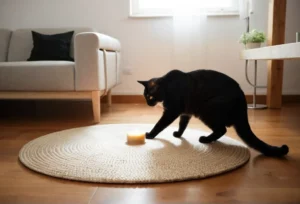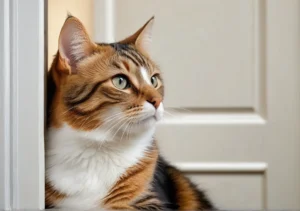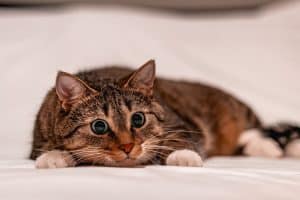Cats can be quite mysterious creatures, with behaviors that often leave us scratching our heads. One common behavior that many cat owners witness is their feline friends hitting other animals. But why do cats do this? Let’s explore the reasons behind this intriguing behavior.
Have you ever wondered why cats hit other animals? Here’s a breakdown of the possible reasons behind this behavior:
1. Instinctual Hunting Behavior
Cats have a natural instinct for hunting, which can sometimes manifest in hitting other animals. This behavior is deeply ingrained in their DNA, as they are descendants of skilled predators. When your feline friend playfully taps or swats at another animal, it’s likely their hunting instinct kicking in. Hunting is a way for cats to stay sharp and satisfied, even if they are well-fed domestic pets.
In the wild, cats use hitting as a way to catch their prey or establish dominance over other animals. So, when your cat is playfully batting at a bird outside the window or gently swatting at a toy mouse, they are simply following their innate hunting instincts. It’s essential to provide plenty of toys and interactive play opportunities to satisfy this primal urge and keep your cat mentally stimulated.
2. Communication and Boundaries
Hitting can also be a form of communication for cats when interacting with other animals. By hitting, cats establish boundaries and assert their personal space. When your cat hits another pet in the household, it may be a way for them to communicate that they are feeling threatened or simply want some alone time. Communication through hitting is especially common among cats who may not share a strong bond or are still establishing their relationship.
To help manage this behavior, create separate spaces for each pet to retreat to when they need some alone time. Providing vertical space, such as cat trees or shelves, can also help cats establish their territory and feel more secure in their environment. Additionally, consider consulting with a professional animal behaviorist to address any underlying issues causing tension between your pets.
Remember, hitting is a natural behavior for cats, but with the right approach and understanding, you can help your pets coexist peacefully in your home environment.
Playful Interaction
Cats hitting other animals can often be a part of their playful interactions. They may use gentle swats or pats as a way to engage with their furry companions, much like how they would play with a fellow cat or a toy. It’s their way of bonding and having fun with other animals in their environment. This behavior is usually accompanied by other playful gestures such as chasing, pouncing, and rolling around. So, if you see your cat hitting another pet, know that it could just be their way of extending an invitation to play.
Dominance Display
When cats hit other animals, it can also be a way for them to assert dominance. Cats are naturally territorial and hierarchical animals, and hitting can be a method for them to establish their rank in the social order. By showing dominance through physical actions like hitting, cats communicate that they are in control and demand respect from others. This behavior is commonly seen in multi-pet households where cats may compete for resources or attention, leading to displays of dominance through hitting.
- Body Language: Pay attention to your cat’s body language when they hit other animals. Puffed-up fur, hissing, or tense postures can indicate that the hitting is more about dominance than play.
- Training and Socialization: Proper training and socialization can help reduce instances of hitting behavior in cats, especially towards other pets. Providing enriching environments and positive interactions can promote harmonious relationships among pets in the household.
- Seek Professional Help: If your cat’s hitting behavior becomes aggressive or problematic, consider consulting with a veterinarian or animal behaviorist for guidance on how to address and manage the behavior effectively. Prioritize your pets’ safety and well-being in any interactions.
5. Fear or Anxiety
When it comes to fear or anxiety, cats hitting other animals can stem from a place of defense or stress. Cats, like humans, have a fight-or-flight response when they feel threatened or scared. In situations where they encounter other animals that they perceive as a threat, hitting may be their way of protecting themselves or establishing boundaries. It’s essential to recognize the signs of fear or anxiety in your cat, such as hissing, dilated pupils, flattened ears, or a puffed-up tail, to address the root cause of their behavior.
6. Curiosity and Exploration
Have you ever noticed your cat hitting other animals out of curiosity or the need to explore their surroundings? Cats are naturally curious creatures, always eager to investigate new things and interactions. When they hit other animals, it could be their way of learning more about the world around them, testing boundaries, or simply engaging in play behavior. Encouraging positive interactions with other animals through supervised introductions and providing enriching environments can help satisfy your cat’s curious nature without resorting to hitting.
Additional Unique Insight:
Remember, cats communicate through their actions, so hitting other animals may also be a form of social interaction for them. By observing your cat’s body language and understanding their motivations behind hitting, you can better support their social needs and create a harmonious environment for all pets in your household.
7. Socialization and Learning
Cats hitting other animals can be a part of their socialization process. By interacting with other animals through hitting, cats can learn valuable social cues and behaviors. This behavior helps them establish boundaries, communicate effectively, and understand the dynamics of social interactions. Through hitting, cats can determine their place within the hierarchy of a group of animals and establish respectful relationships with other pets or feral animals in their environment. So, while it may seem aggressive, hitting can actually serve as a crucial learning experience for cats in navigating their social world.
8. Unique Cases and Exceptions
In some unique cases, cats may hit other animals for reasons beyond the typical explanations. For instance, cats with a history of abuse or trauma may resort to hitting as a defensive mechanism or a coping strategy. Additionally, cats that have not been properly socialized from a young age may display hitting behavior as a result of fear or anxiety in unfamiliar situations. It is essential to consider the individual history and temperament of each cat when trying to understand their hitting behavior, as there may be underlying factors that contribute to their actions. By observing and addressing any potential triggers or stressors, cat owners can help mitigate hitting behavior and create a safe and harmonious environment for their pets.
Interesting Facts: Cat Body Language
Cats communicate through a variety of body language cues, including hitting or swatting. When they hit other animals, it can be a way of setting boundaries, expressing playfulness, or even showing fear or aggression. Pay attention to the context and other signals to understand what your cat is trying to convey. Remember, hitting is just one piece of the intricate puzzle of feline communication.
Additional Unique Insight:
Cats may also hit as a form of social grooming. In multi-cat households, hitting can be a way for cats to bond and establish hierarchy within the group. So, don’t always interpret hitting as a negative behavior, sometimes it’s just their way of interacting and building relationships.
Conclusion
Understanding cat behavior, including hitting other animals, can deepen your bond and strengthen your relationship with these mysterious yet fascinating creatures. By learning to read their body language and decipher their signals, you can create a more harmonious environment for your feline friend. Remember, cats have their unique ways of communication, and by respecting and understanding these, you can truly appreciate the special bond you share with your furry companion.
Alex, a passionate animal lover, has experience in training and understanding animal behavior. As a proud pet parent to two dogs and three cats, he founded AnimalReport.net to share insights from animal experts and expand his knowledge of the animal kingdom.




